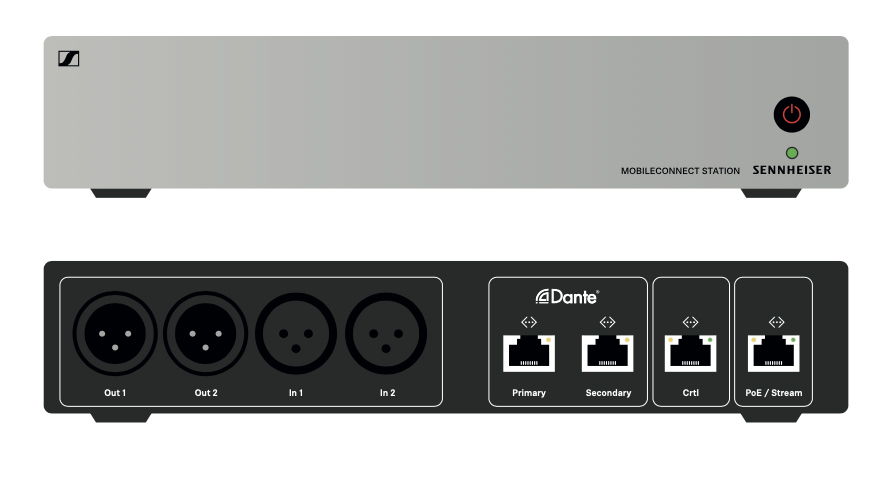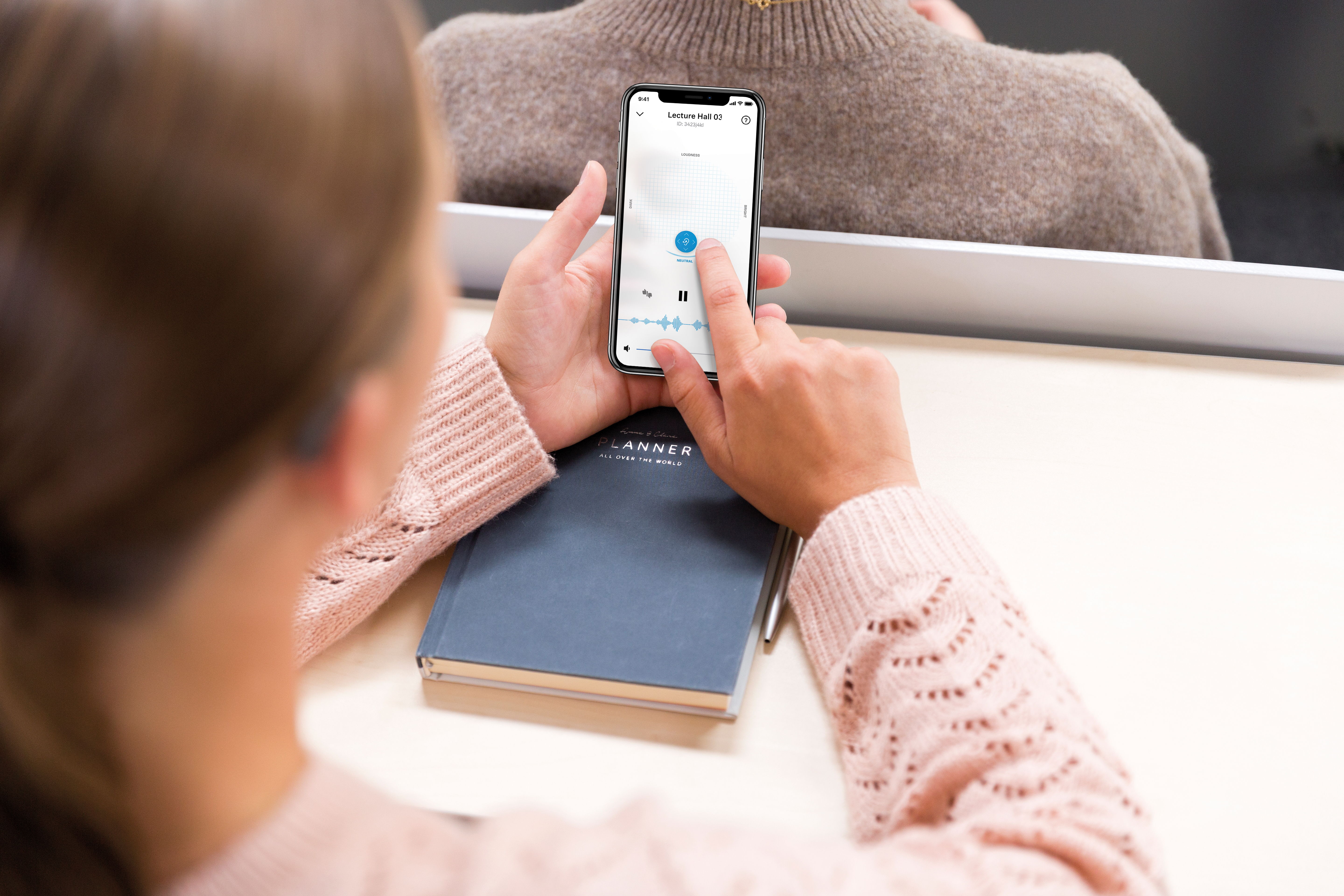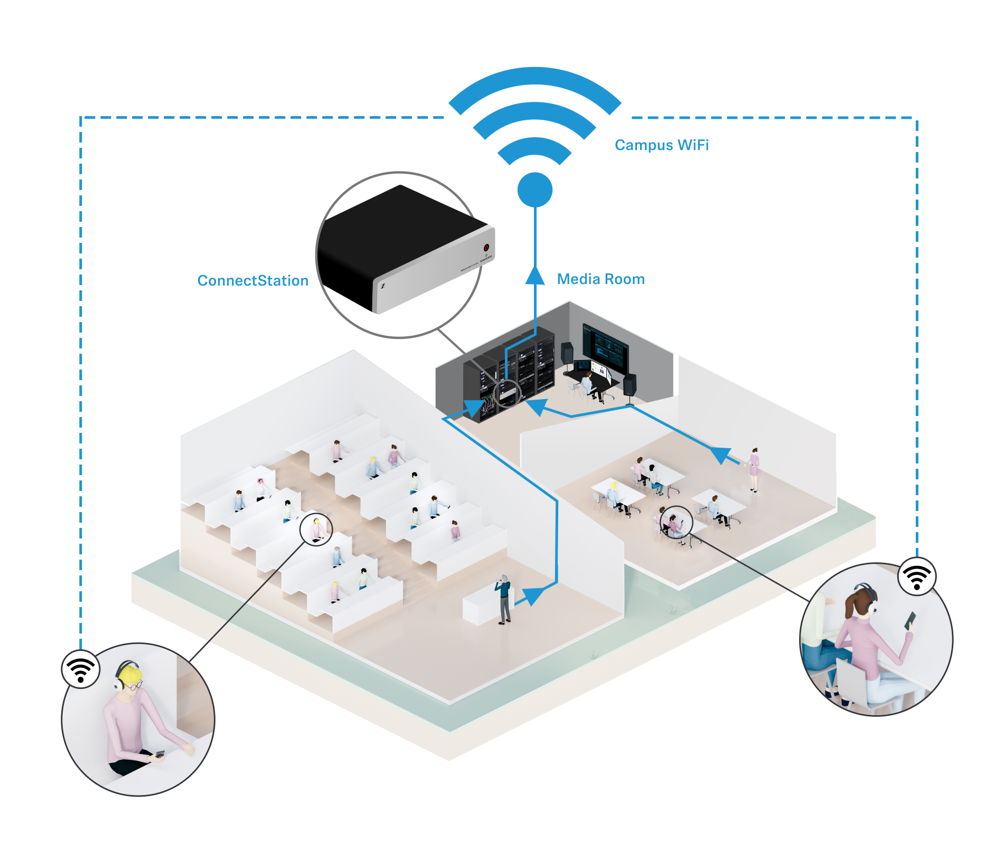Osallistavaa ja yksilöllistä avustavaa kuuntelun tukea opiskelijoille
11. helmikuuta 2020

Sennheiser esittelee uuden sukupolven MobileConnect -suoratoistoratkaisusta
Helsinki/Wedemark/Amsterdam, 11 February 2020 – At this year’s ISE, Sennheiser is showcasing the new generation of its MobileConnect streaming solution, which offers students an individual assistive listening capability through the convenience of their own smartphone. The system offers operators every possibility to implement even complex architectures easily and reliably and to manage them from a central location. The Wi-Fi-based MobileConnect system delivers high audio quality with low latency and will be available from March.
“MobileConnect provides assistive listening in an extremely simple way via Wi-Fi and the student’s personal smartphone,” said Jakub Kolacz, Manager Product & Commercialization at Sennheiser Streaming Technologies. “Students do not have to borrow a special receiver or sit in a designated area but can choose their seat wherever they like in the lecture hall. That is real inclusion.”

How MobileConnect works:
The audio signals from the lecturer’s microphone are sent to the MobileConnect Station. There, the signals are converted into network-compatible, digital packets. The audio data are transmitted to the Wi-Fi access points via the Station’s network output, allowing them to be accessed anywhere throughout the campus’s Wi-Fi network. The students simply enter the channel number in the smartphone app or scan a QR code to enable them to listen to the audio signal through headphones, induction accessories or a cochlear implant and to adjust the sound to their individual needs.
“There are also many advantages for the operators of the system,” Kolacz continued. “MobileConnect uses the university’s Wi-Fi network and can be quickly integrated and centrally controlled. What is more, the BYOD principle and the use of the existing Wi-Fi infrastructure mean that operating costs are significantly lower – and users are happier.”
One system – three elements
MobileConnect consists of three components. The MobileConnect Station has the job of converting the audio signals into network-compatible, digital packets, while the MobileConnect Manager software enables the system to be centrally controlled, and the MobileConnect App ensures that the audio stream can be optimally personalised and played on the student’s smartphone.
The MobileConnect Station is the hardware of the system; it collects the audio signals. A station has two audio channels, and the software can control a multitude of stations, which means that even large campuses can be covered. The audio data can be fed in either through two analog XLR inputs – for example for a lecturer and simultaneous interpreting – or through the station’s redundant Dante ports. Two LAN ports are available for control, the audio stream and PoE, which means that two separate networks can be used for the audio stream and administration. The audio data go to the access points of the Wi-Fi system via the audio stream output and can therefore be accessed anywhere on the campus.

The MobileConnect Manager makes it possible to conveniently manage the entire system from a central location. The IT team can access and process all of the channel information. For example, they can hide channels, assign channel numbers and switch between mono and stereo playback.
The MobileConnect App for Android or iOS turns a smartphone into an audio receiver. Students do not need to become accustomed to a separate device and are able to use their hearing aids as usual or listen through headphones. The audio stream is accessed via Wi-Fi by entering the corresponding channel number or scanning a QR code. As the system is Wi-Fi-based, the students are no longer excluded from other information and can stay in touch at all times.

The app’s Personal Hearing Assistant can adjust the audio signal to suit the listener’s individual preferences. A waveform animation provides visual feedback on the audio stream.
“With MobileConnect, we provide the ideal streaming solution for individual assistive listening, no matter how large or complex the campus might be. The system offers many advantages for both operators and users thanks to Wi-Fi and BYOD – and that also applies, of course, to applications outside the educational field,” said Jakub Kolacz, summarising the system’s benefits.
Info box: The MobileConnect "Bring Your Own Device" concept
MobileConnect turns the student's own smartphone into an audio receiver. This means that students do not have to get used to a new device, and they are sure to have complete compatibility with their own hearing aid. Wi-Fi transmission enables students to sit wherever they like in the lecture hall, while the MobileConnect App also allows the sound to be inidvidually adjusted.
There are also many advantages for the operator, for example the university. MobileConnect uses the exisiting Wi-Fi network, which means that there is no need to install a special service. Maintenance costs are much lower, thus significantly reducing the total cost of ownership (TCO).
Info box: What the IT team needs to know
The new architecture ensures that the second generation of MobileConnect can be perfectly integrated into complex IT networks. MobileConnect transmits via the university's Wi-Fi network in unicast mode, which guarantees the low latency that is necessary for assistive listening (approx. 40 milliseconds) as well as a stable stream with high audio quality.
Wi-Fi technology provides access for up to 100 clients (users) in a room. The control data (TCP) and audio data (UDP) are transmitted via separate networks. The system supports NAT, DNS Service Announcement, subdomain rules, and various IP subnets. The MobileConnect Manager is supplied as a software container.
First-generation MobileConnect Stations can be given a firmware update that enables them to be integrated into the new Wi-Fi-based system and centrally managed.
Visit Sennheiser at ISE, Hall 2, Stand B 50.
Maria Kellokumpu

 How MobileConnect works: The audio signals from the lecturer’s microphone are sent to the MobileConnect Station. There, the signals are converted into network-compatible, digital packets. The audio data are transmitted to the Wi-Fi access points via the Station’s network output, allowing them to be accessed anywhere throughout the campus’s Wi-Fi network. The students simply enter the channel number in the smartphone app or scan a QR code to enable them to listen to the audio signal through headphones, induction accessories or a cochlear implant and to adjust the sound to their individual needs.
How MobileConnect works: The audio signals from the lecturer’s microphone are sent to the MobileConnect Station. There, the signals are converted into network-compatible, digital packets. The audio data are transmitted to the Wi-Fi access points via the Station’s network output, allowing them to be accessed anywhere throughout the campus’s Wi-Fi network. The students simply enter the channel number in the smartphone app or scan a QR code to enable them to listen to the audio signal through headphones, induction accessories or a cochlear implant and to adjust the sound to their individual needs.MobileConnect_en.docx
DOCX - 951 Kb
MobileConnect_en.pdf
PDF - 249 Kb

